Winter returns with a vengance but we dodge the "snow bullet" again
Friday, March 29, 2013
The weather has dominated our gardening life this month with
some very cold days and nights, persistent easterly winds,
occasional heavy rain and the warmest day of the year! Amazingly
again we have had no snow here. Strange to say but it has been
quite enjoyable and we have done a lot of jobs. However unlike last
years warm March we have not been lured into planting out too soon
or to make a start on the vegetable garden even though the borders
are quite dry thanks to the drying winds. The humidity has been
very low with readings averaging the mid 30's% so many of the
plants in growth are looking quite dessicated especially the new
hydrangea growth which was well advanced because of the mild
February.
Our own Welsh "Mount Fuji" - The Sugar Loaf
near Abergavenny in east Wales

In spite of the cold the daffodils are starting to
flower and one of the best is this Division 6 cyclamineus hybrid
"Jet Fire" All daffodils in this division are fairly short, upright
and bulk up quickly.
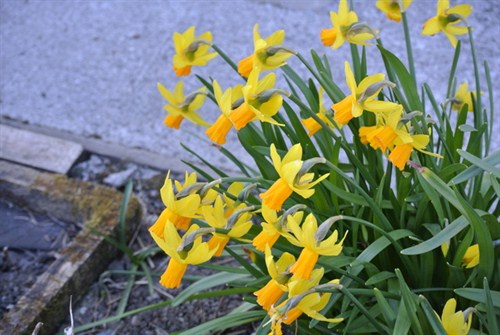
Weather
The coldest March since 1963 but a max of 14.4C in the
first week of the month was countered by a low of -9C, the coldest
of the winter on 14th. Overall 16 nights of air frost and just 4
days above 10C. The biting easterly wind has been an ever present
feature of the month.
Garden Update
In the warmth of the polytunnels seed sowing and potting on has
continued, unaffected by the weather. The benches of seedlings are
growing away but the lack of any warm spell or bright sunshine has
held back development of seedlings. All plants in the nursery have
been repotted and we have recently made a start on the large stock
plants in the tunnels
The latest pic. of the seed bench showing in the
foreground the grass like seedlings from the American Hemerocallis
seed.
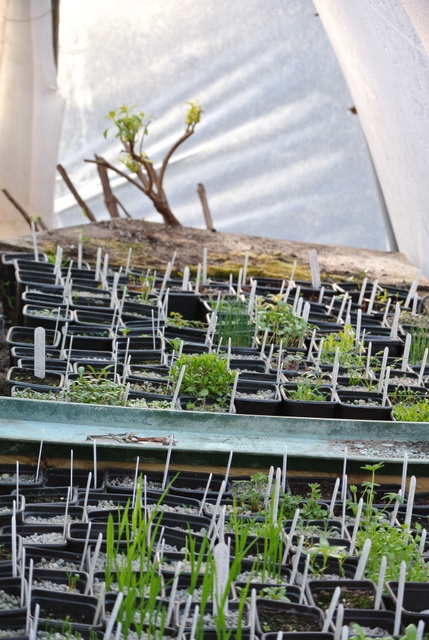
My hemerocallis seeds from the American Hemerocallis Society
have germinated beautifully in just 4 weeks and the seedlings are
already 4 inches tall - they are really easy from seed and because
they are hybirds will make vigorous plants. The anticipation of
them flowering perhaps as early as next year is very exciting.
In spite of my best efforts over the years to improve the lawns
I have not met with any great success so this month I resolved to
take drastic measures. Yes I know that a perfect lawn is now out of
fashion and not considered enviromentally sound for a whole host of
reasons, but nothing sets off the borders so well as a lovely green
sward. Take it from me having opened the gardens for 14 years, the
"general public" love nothing better than a well kept, weed free
lawn and good on them I say!
Advised and encouraged by Robert, our friend and former
greenkeeper, I have seriously scarifed the lawns much deeper than
ever before, to within a inch of their life, and recently
hired a powered spiking machine to get some air into them. Followed
by a top dressing and re-seeding they now look pretty tatty but my
guru assures me they will look wonderful in a couple of months
time. I trust his judgement but our first visit this summer is just
9 weeks away!! Just to ensure they stay that way I recently
invested in a quality, vintage Webb cylinder mower circa
1980, still cutting beautifully.
The lawn guru Rob hard at work on the hollow tine
spiker - spot the grass!
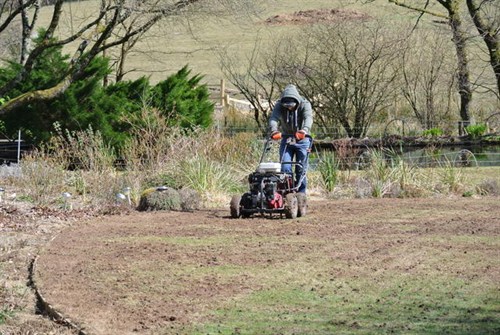
Some pleasing border shapes take attention away from the
scalped lawns
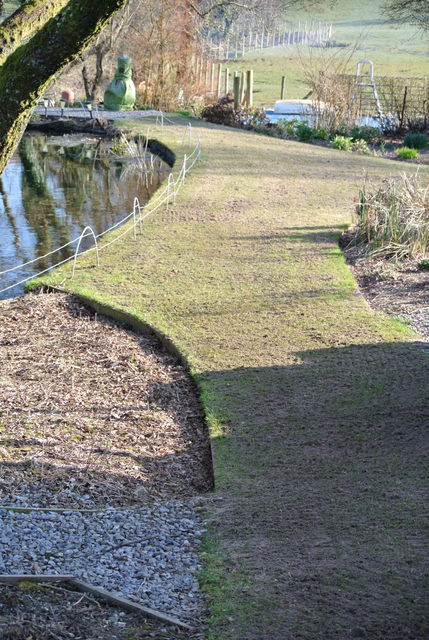
The resultant waste from the lawns - a trolley
load of dense thatch. I carted 17 loads of this from the Paddock
Lawn

What's looking good?
Pretty much the same things as last month. It has been so
generally cold that all the early spring flowers are still going
strongly with many snowdrops still in flower with primroses and
celandines - an unusual overlapping of bloom times. The mighty
Hellebores (sorry to mention them again but regular readers will
know that they are my only gardening weakness!!) just go on and on
and on with the woodland area in particular looking splendid. There
they now share the limelight with pulmonarias Blue Ensign, Lewis
Palmer, Sissinghurst White and a range of countless hybrids as they
cross readily from seed. And cyclamen coum now in their fourth
month of flowering, some having started before Christmas - I cannot
recommend them highly enough.
Pulmonaria "Lewis Palmer" a really "good doer" which has
flowered in the woodland area for over 15 years
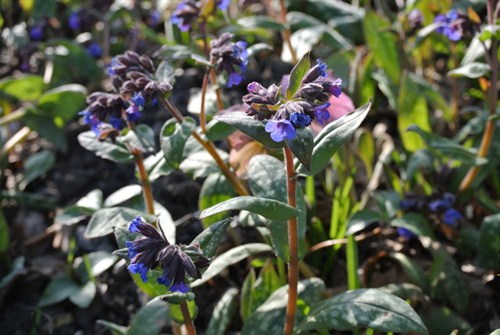
Hellebores still going strong in the
woodland.

In the warmth of the large polytunnel, the first flowers
on fuchsia arborescens (sometime called the lilac flowered
fuchsia)

Daffodils continue to be patchy and I do fear that many of mine
planted up to 20 years ago are going backwards and need to be
replenished. They are certainly very late this year. My dear farmer
neighbour Meirion who sadly passed away last autumn used to say
that daffodil season always brought "back and forward " weather and
that proper spring would not come until we see the back of these
"yellow buggers!" Not what you expect form a proud Welsh speaker
but his sentiments are nonetheless true in my experience.
A final mention must be made of plants in the nursery. By
overwintering all my plants under cover of frames, tunnels and
greenhouses and aided by a generally milder winter (this month
excepted) we have had almost no losses, the secret being keeping
the pots on the dry side. Plants in pots can be very tempremental
during the winter months especially if after being soaked they are
then subjected to cold causing the pots to freeze solid. Even
plants that are totally hardy in the ground, like hardy geraniums,
perennial digitalis, poppies, hollyhocks and occasionally lupins,
in pots can fall prey to extreme temperature changes.
Wildlife and Countryside
Just when I was wondering what I could report on this month
(apart from lambs everywhere) along came 2 bird related incidents
within a few minutes of each other. Working on the lawns, I heard a
shrill whistling over the Paddock Pond and looked up to see 2
kingfishers having a stand off not far away from me. Totally
oblivious they kept this up for about 30 seconds before flying off,
one still chasing the other. I expect given the time of year there
was a young lady nearby to be impressed by their show of force! I
have only ever seen solitary kingfishers before.
They will be glad they made off because a goshawk, one of the
most agressive birds of prey came into view, circling over the
valley and it was interesting to observe the panic of birds great
and small trying to get to cover as quickly as possible, just like
when the gunslinger came into town in an old fashioned Western
movies. On this occasion happily no -one got the bullet!
My"pet" robin (rob.i.am of internet fame - his words not mine!)
has been around most days continuing to develop his love of cheese.
He now comes into the polytunnel, perches on a watering can or
other vantage point, and sings in a very agressive manner until I
throw him some cheese. He knows where I keep it in a plastic bag
and if I don't give hime some he just goes and helps himself!!!
Sadly these events are beyond the speed of me or camera to
capture
Rabbits continue to be much in evidence all over the gardens and
in spite of late evening and early morning patrols I have failed to
see any. It does not bode well with the main spring planting only
weeks away and I have no choice but to get the experts in as my
attempts to trap them in humane traps have been mostly
unsuccessful.
Oh and I nearly forgot! The frogs kept us waiting this year but
in the brief warm interlude in early March with a little rain they
came back to the Paddock Pond in their hundreds where most of them
will have started their lives. I hope the cold weather and frequent
ice on the pond will not have damaged all the spawn;we will soon
know.
Visits
The only visits this month have been to garden clubs for talks
and two Gardeners Question Time which are great fun and learning
opportunites not only for members of the audience but also for
panel members. For example I learned that wood ash, a very good
source of potash if used fresh, can contain up to 60% lime, which
needs to be appreciated especially in areas like the Cotswolds
which already have a high lime content in the soil. I also learned
in regard to tomatoes that you should not plant them into their
final positions until the first flowers are showing colour. In this
way the first truss will be earlier and much lower on the plant
than if you plant them out before the flowers form. Simple things
perhaps but invaluable advice. It's the little things in gardening
that can make a difference.
I also gave a talk to Sketty Gardening Club in Swansea which was
attended by over 80 members, the largest group I have ever spoken
to. It was great to have such a large and participative audience
and a wide range of questions was asked - I do love it when there
is a 2 way dialogue and active member participation.
In view of the paucity of pics for this month's news we recently
took a trip to the Cotswolds to visit our friends Tony and Sylvia
who have a nursery specialising in a wide range of woodland and
other shade plants many of which flower at this time of year. Here
are a few pics of some of the treasures currently in bloom, all of
them under heated protection I hasten to add..
The striking inflorescense of a form of amorphophallus
konjac, the flowers coming before the architectural and imposing
leaves. The flowers have a few days when they are very smelly to
attract polinating insects. A relative of the "Titan Arum" arguably
the largest flowering plant in the world. These spikes are a mere
3-4 feet long.

This lovely trillium could be t. sessile but Tony is not
sure and it may be a hybrid
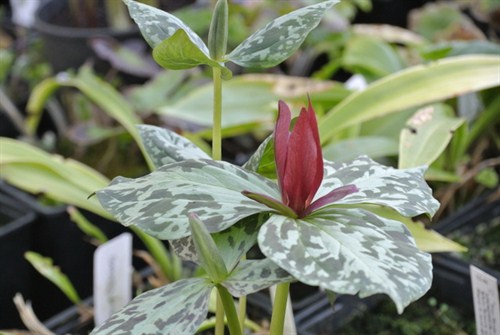
And finally this fabulous and rather unusual hellebore
with lovely symmetry to the markings

For more details of Tony and Sylvia's nursery and the Plant
Fairs they will be attending this year go to www.shadyplants.com